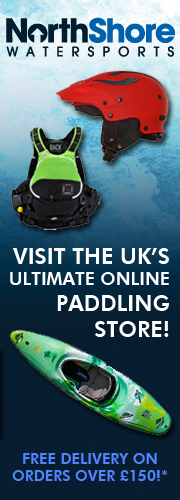If you don’t know, double pumping is the forward – backward stroke on one side that initiates most cartwheels (you can also plough the nose down to get up on end, but that’s just brute force, no technique.)
What you need:
A boat that’s designed to do what you want it to. Try a boat that has low volume, slicey ends – not a big ass creeker. Stay away from long, fat boats.
Short paddles make a big difference, so see if you can borrow someome’s playboating blades. Ask though, and treat them with care.
And a good set of stomach muscles. They’re gonna hurt.
Pretty much, what a double pump is, is a powerful forward stroke on one side (usually the right) followed by a backward stroke on the same side, coupled with an aggressive edge, so as to rock the boat from bow to stern and back again. It starts off the cartwheel.
Start off doing a forward stroke on your right, never mind about boat angle yet. Wind up your torso before putting in the stroke. Think of your legs and the boat as a pair of scissors. Use your hips and legs to force the boat away from the paddle during the forward stroke, and together in the back stroke. As you go through the stroke, lead it through with your head – ie – look ahead where your paddle is going to go, and in the direction you want the boat to turn. Always always lead with your head, it makes it much easier.
Then do it backwards, put in the blade at the stern, unwind your torso to the front, lead with your head until the blade hits the nose of your boat.
The paddles want to be good and close to the boat. The nearer they are, the more power you have access to. The farther away, the more control you have. When you’re putting in the backstroke, it should look as if you’re setting up for a rool – the blades should be parallel to the boat.
Got that?
Next, introduce the angle of edge.
If you’re practising on your right, then you want to be able to drop your right knee, and hold it there solidly, keeping you body upright in the boat, standing still and paddling. This has the effect of getting the boat and its large flat planing hulloff the water surface, and engaging the nice and slicey edges. The idea is that you’re rocking the boat from bow to stern, and back again, and using your center of mass to accentuate this.
For this part, remember that you have to keep your weight over the boat. When ploughing down a stroke, remember that even though it would be more powerful if it had your weight behind it, the paddle will not keep you afloat, but the boat will.
Also, keep in mind that the inherent buoyancy in the boats will help you here. When the stern is down, and you’re smashing down the bow, the air in the back of the boat will aid the nose of the boat going down. Likewise, gravity will pull down the nose when you’re on your tail.
Start off the same way as described above, but instead of sweeping in a flat circle, when you put in the front stroke, edge up your boat on the same side, and lean back, adding your weight to the stern, driving it downwards, while lifting the bow up and out of the water. All things going to plan, it should be something like “Holy sh1t, I’m vertical!”
Remember, lead with your head, and try and scissor your legs and blade apart.
That should have wound your body up for the reverse sweep on the right to smash the bow down. As the stern rises, you must apply the stern sweep while throwing your weight forwards, towards the bow. this will drive the nose down til it too stalls. That’s pretty much the stroke, but if this is what you’re practising, then it takes a bit more to actually cartwheel, as you have to keep you weight moving to fall over on the far side.
Remember:
Don’t lean on the paddle – you can put the turning force of your torso on it, but don’t put you weight over it. If you lean on your blade, you’ll sink it into the water, and then not be able to get on to the next stroke. More inportantly, your weight won’t be on the boat, in order to drive the ends down.
Keep the edge up. With a low edge, it’s a lot more work to get vertical. If you edge too much though, you’ll go over. Practice practice practice!
If you think I’m full of sh1t, write one yourself. What works for one person will not work for everyone else. Everybody has to find their own particular way of doing things. Don’t hesitate to ask older paddlers for a tip if you’re not getting it.
Also, if I’ve left anything out, tell me.
Cheers, and I hope this helps, JK



Leave a Reply